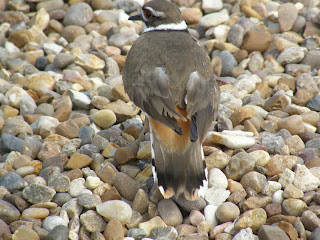Last week a Killdeer began laying eggs in the newly placed
gravel in front of the Hagerman NWR Visitor Center, near the bicycle rack. Just about this same time a year ago a
Killdeer chose an area much nearer the front door for her ”nest” and was
frequently seen hopping about trying to distract passers-by, but this year the
nest area is a little more out of the traffic pattern.
 |
| Killdeer photographed near Visitor Center by Dick Malnory |
We are hoping for a repeat of last year’s nesting success,
as in 2012, we believed that the same Killdeer had two successful hatches from the same spot, with
babies led into the nearby fields the day they hatched. Many visitors enjoyed checking on the nesting
progress, in person and on Facebook.
The following is reprinted from the April 26, 2012, blog post by Bill Hughes, on "the killdeer, a species belonging to a family of birds known as plovers. The bird’s name comes from its repeated loud and strident call “kill-deer”. Its call was the origin of an earlier name, the noisy plover.
Although the killdeer is considered a shorebird, it is often found far from water in grassland habitats such as fields, meadows and pastures. During the summer breeding season, the killdeer nests from the southern United States to Canada. Nesting begins in March in the deep South, April in the middle states, May in the northern states and southern Canada and June in the far north.
The killdeer’s nest is very basic--a shallow depression in the ground in an open area with some stones (graveled roofs are used) and sparse to no grass. The depression is formed by a “scraping” action of both the male and female bird.
 |
| Killdeer, eggs, in field near Visitor Center, 2012, by Dick Malnory |
The killdeer frequently uses a "broken-wing" display to distract predators (and humans) from their nests. In the display, the bird walks away from its nesting area holding its wing in a position that simulates an injury and then flutters around on the ground while emitting a distress call. Predators are attracted to the seemingly injured bird and are drawn away from the nest.
As is the case for our pair of killdeer, the number of eggs laid is typically four. The smooth, ovate-shaped eggs are dull tan or cream to yellow-gray in color with varied shades and sizes of irregular darker-brown blotches.
 |
| The Killdeer nest with 3 eggs, taken March 25, 2013, by Kathy Whaley |
The simple structure of the nest and the spots of the eggs, which disguise them as stones, make the nest and eggs blend remarkably into their surroundings. This camouflaging effect is very apparent for the nest at the Visitor’s Center.
The eggs are usually arranged in the nest with the pointed ends together and positioned downward in the center of the nest. If disturbed, the birds will restore the eggs to their original positions. Both the male and the female incubate the eggs; the male more often at night. The eggs hatch in about 24-28 days; all four eggs usually hatch within an eight hour period.
Killdeer hatchlings are precocial, a term applied to young birds that are able to see and search for food soon after hatching. For this reason, killdeer are not known to feed their young. Newly-hatched killdeer can't fly, and they need the protection provided by the adults. They are brooded extensively during the first three days after hatching. Around one month after hatching, the young are fledged.
The killdeer is by far the most wide-spread and well-known of North American plovers. Other plovers that could be seen at Hagerman, but are much less common than the killdeer, are the American golden plover, black-bellied plover and snowy plover. These plovers are migrants that pass through the refuge but do not nest here.
The killdeer is one of the most successful of all shorebirds because of its tolerance for human modified habitats, such as lawns, driveways, athletic fields, parking lots, airports, and golf courses; and its willingness to nest close to people. However, because they live near people they are vulnerable to pesticide poisoning and collisions with cars and buildings. Presently, the range and population of the killdeer are considered stable."



No comments:
Post a Comment